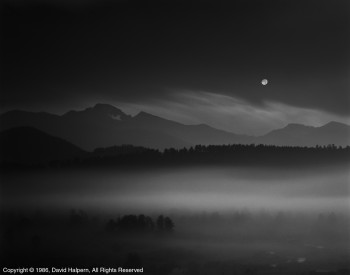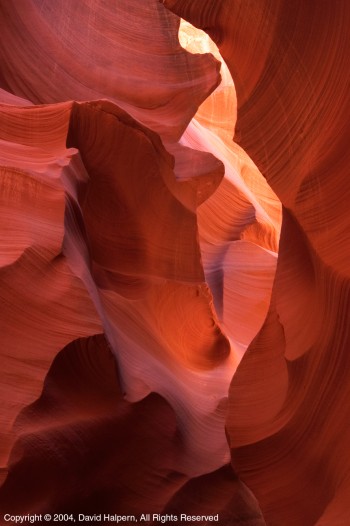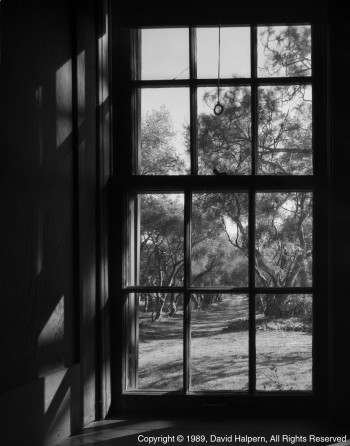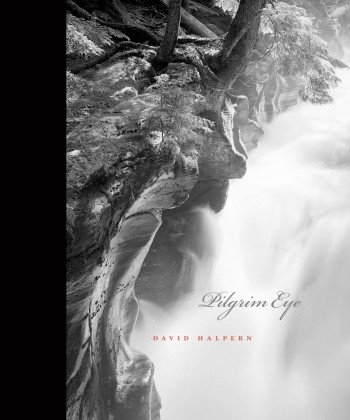 Follow more than 50 years of photography wisdom at David Halpern’s new blog, simply and fittingly called David’s Blog. Though an old-school photographer, Halpern has also embraced new-school technology, whether it’s front-end editing software or the latest large format inkjet printers and media. Halpern’s old-school approach is in the capture – lighting, perspective and emotion – not in the tools.
Follow more than 50 years of photography wisdom at David Halpern’s new blog, simply and fittingly called David’s Blog. Though an old-school photographer, Halpern has also embraced new-school technology, whether it’s front-end editing software or the latest large format inkjet printers and media. Halpern’s old-school approach is in the capture – lighting, perspective and emotion – not in the tools.
Halpern’s forte is outdoor photography and has been capturing the best America has to offer as an artist in residence for the National Park Service, from Rocky Mountain National Park and Glacier National Park all the way to Acadia National Park in Maine.
For the full story, check out the profile below reprinted from an earlier edition of LexJet’s In Focus eNewsletter. And, since the article’s a few years old now, make sure to catch up with Halpern at David’s Blog: http://davidhalpern.com/blog.html.
Pilgrim Eye: David Halpern’s World of Discovery
Beyond the sheer volume and quality of David Halpern’s body of work over the past 50 years or so, perhaps most impressive is his continual pursuit of maximizing his art through new ideas and new technology.

“I have a photo of a scene I took in Muir Woods in 1952. I took that negative and scanned it a few years ago, and for the first time I discovered that there are people in the background walking in the woods. I never saw them in any of the silver prints I made. I was able to bring out so much more through the scan and was able to create a range of tone I had never seen before,” recalls Halpern. “That is really exciting. I’m producing images now that are digital from the start, but I can go back and take those wonderful film images I did 50 years ago, scan those pictures, and bring them so much more to life than they ever were before. I get up every day and figure, hot dog, today I’m going to learn something I didn’t know yesterday. And I do, and it’s really wonderful.”

Halpern started shooting digital about ten years ago, and began doing his own printing for exhibitions and re-prints of his work almost immediately.
“When I first started printing I was mostly concerned about my black-and-white photography, and I wanted to produce something that compared favorably with what I did with silver prints,” explains Halpern. “There’s a purist ideal we’ve grown up with for years that there’s nothing as good as a silver print that will last for centuries. This is quite true, and it’s a wonderful medium, but on the other hand I wanted to move on to something else. I wanted to see what was around the bend. I’ll never stop taking and making pictures; doing what I really love, which is putting these images on paper and hanging them up for the world to appreciate and hoping they’ll love this natural landscape that is America as much as I do.”
A Pilgrim’s Travels
With the recent publication of his retrospective photography book, Pilgrim Eye, Halpern has been able to do just that. And, he plans to create a small traveling exhibit of his work that will mirror the intent of the book, which is to bring America’s landscapes to the wider public.
Halpern says a smaller retrospective showing will allow people in smaller towns who normally don’t get a chance to see this type of artistic interpretation the opportunity to do so. Starting with his home base in Tulsa, Halpern’s exhibit will also feature a mix of photographic papers, from traditional silver prints to inkjet prints on LexJet Sunset, Hahnemuhle, and Epson papers.

“I want people to be able to see a silver print and a digital print of the same image hanging side by side, not to say that this is better than that, but to say it’s different, and look where we’re going,” he explains. “We put together an exhibit of Milestone Images that accompany the initial presentation of the book at a local gallery. They’re pictures taken over the course of my 50-plus years of my career that represent a shift in my thinking or a discovery of something that I felt was important.”
By a Clearer Light, Halpern’s 1992 celebration of the 75th anniversary of the National Park Service, followed the same pattern. For five years, the exhibit traveled to 39 public venues from California to Massachusetts, and from Texas to Montana, and was seen by more than half a million people.
Halpern has been an artist in residence for the National Park Service 11 times, serving at Rocky Mountain National Park, Bryce Canyon National Park, Black Canyon of the Gunnison National Park, Glacier National Park, and Acadia National Park in Maine.
“It’s a wonderful opportunity, because how often do you get the chance to live in a park? You get access to everything in the park, and you share a portion of your work with them so it can be used for educational and interpretive purposes,” Halpern says. “While I’m technically retired from commercial practice, I get called out of retirement regularly. I’m probably working harder today than when I officially worked full-time.”
The bulk of the images in Pilgrim Eye come from Halpern’s photographic interpretation of America’s landscape, particularly the West. Judging by its contents, and by conversing with Halpern, there’s no doubt that this is where his photographic passion resides.
An Artist’s Medium & Message
However, this is only part of Halpern’s story in photography. Much of his philosophy and the honing of his talent came from years of commercial and architectural photography, which he began to do professionally in the ’70s.
But Halpern’s abilities go far beyond the camera eye as he played the role of marketer, creative director, and consultant for many of his clients. Halpern has an innate knack for seeing beyond the surface, whether it’s a natural landscape or an industrial photo shoot.

“I took a slightly different approach to commercial photography. I didn’t look at my job as strictly making pictures; I was solving problems. I would ask clients what they hoped to achieve, and they would sometimes indicate through their answers that they weren’t at a point where they needed to be talking about photography, brochures, and all that,” recalls Halpern. “What they really needed to do was analyze their marketing objectives and see where they wanted to go. A lot of times I would try things they might have tried before but hadn’t worked because of flawed execution.”
In Halpern’s book, Pilgrim Eye, he is quite candid about the evolution of photography, and brings a refreshingly objective view about his art and the state of the art in general in what is a subject-oriented tome. Just as he guided commercial clients years ago, the book explains the importance of having a Pilgrim’s Eye view of the world. As Halpern puts it, “The explorer travels to discover and investigate; the pilgrim travels and investigates to discover the sacred. When the eye beholds the sacred, one begins to better see oneself.”
In analyzing inkjet printing, Halpern writes in Pilgrim Eye: “In the past few years, print collectors have been introduced to the term giclee (jee-clay), a word derived from the French verb gicler (to spray), describing what is, essentially, a high quality ink-jet print. I am certain the word was invented because art dealers were fearful of using ink-jet to describe a fine art process. Legitimately, the process does need to distance itself from the output of the common desktop printer, but I dislike the pseudo sophistication of the word giclee and prefer simple, more descriptive terminology. Inasmuch as the traditional black and white photographic print is regularly called a silver or gelatin silver print, it might be apropos to call a print made on one’s digital printer a pigmented ink print. Collectors should be informed clearly and simply with information substantiated by reliable research and expertise. After all, the protection and preservation of fine art is not an issue confined to photography, and no medium is truly permanent.”
Pilgrim Eye beautifully enshrines almost 71 years of life, and almost as many years in photography, through its prose and a generous helping of Halpern’s attuned photographic pilgrim eye.
Halpern says his love for photography began when he was 11 or 12 years old. He was fascinated by his uncle’s Argus C-3 camera. Once he began shooting, he would take pictures of people for a quarter apiece and eventually saved up enough to buy his own “real” camera, a Century Graphic purchased around 1951. “A real camera was one where you could actually adjust something,” laughs Halpern.
“I was fascinated by the process. I loved the smells of the darkroom, and that sticks in my head to this day. There was a time when I could tell the difference between different brands of chemicals and different types of paper, just by their smell,” says Halpern.

The future of Halpern’s work is best told in the closing words of Pilgrim Eye: “What will I be doing years from now? Making pictures. And no doubt embracing new technology about which we can now only speculate. What I will be doing tomorrow will be better than what I can do today, and I will continue to be more excited than ever about photography, its challenges and its potential application to creative art. There will be more landscapes to explore, and I will try to find more ways to interpret them.”
For more information about David Halpern’s book, his work, and his philosophy, go to www.davidhalpern.com and http://davidhalpern.com/blog.html
